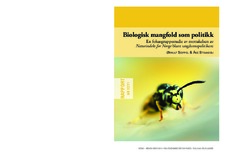| dc.description.abstract | In 2005 the political parties constituting the Norwegian Government declared that they wanted to introduce a nature index providing a picture of developmental trends in Norwegian nature. In September 2010 The Norwegian Directorate for Nature presented the first Nature index for Norway (NI): an overview of the situation and development for nine central ecosystems. The results show varying trends. The situation for ‘forest’ and ‘open lowland’ is relatively poor, whereas the situations for the other ecosystems were, although varying, less precarious, for some good and improving. One of the explicit aims of NI were that the results should be of help for future environmental policies. This report is an answer to this last challenge, and aims at an answer to two questions. First, we want to find out how politicians conceive of the results from NI: Do they actually understand the message? Second, we would like to see how a biological diversity policy actually is articulated by Norwegian politicians: Is biological diversity an issue of concern to them? Do they consider it a pressing issue? How do they look at the relation between scientific knowledge and politics? How does biological diversity as in issue fit in with existing political cleavages? What kind of policy tools do they see as relevant for a policy based on the information from NI? To find an answer to these questions, six focus group interviews with members of the youth organizations of six political parties where conducted. As an introduction to each interview, the participants were given a 25 minutes introduction to the results from the NI. Thereafter the groups discussed biological diversity as a political issue, to the extent it was necessary, guided by the researchers’ interview guide. The groups consisted of four to eight participants, from 17 to 27 years of age. For the first research question, all involved participants reported that they understood the results presented to them from the NI. When given the opportunity to comment on NI, two themes appeared more often than others. First, the question of reference situation (what is the optimal biodiversity in different ecosystems?) was not clear to everyone. Second, there was some discussion regarding what is called expert knowledge which were based on more qualitative knowledge (in lack of quantitative data). The main question addressed how youth politicians actually articulate biodiversity as a political issue, on the background of a presentation of NI. The study summarises the answers to this question along four dimensions. First, when it comes to the theme of biodiversity, we see that, with a very few exceptions, none of the participants have any special knowledge or interest in this issue. Even though all agree that biodiversity is an important issue when they actually are asked to discuss it, few participants are seeing this as an issue requiring immediate action. Scientific knowledge is of uttermost importance for understanding the issue of biodiversity. Even though none of our participants were very critical towards NI when it was presented to them, they all revealed a deep uncertainty with respect to scientific knowledge and most also a certain scepticism towards science. Apart from this common scepticism, there are significant differences when it comes to what kind of research (f ex IPCC) they actually trust and the extent to which they consider research a good policy tool for nature preservation. For a theme to have some political momentum, it has to be linked to other political issues and ideologies, and in the interviews two such cleavages stood out as important. First, there is the traditional left-right cleavage. On the one hand, there was a tendency, for both left and right, to emphasize that biodiversity and nature preservation are issues with a broad appeal, on the other the more leftist parties expressed a clearer intention to prioritize ecology at the cost of economic matters than the rightist parties. As a political issue biodiversity often equals nature or species preservation which in practice implies that more rural districts have to carry the cost of general interest. For four of our focus groups this meant that national institutions should take the necessary decisions concerning biodiversity, whereas two other groups tend to prioritize local development and welfare at the cost of general interests. On a question of relevant policy tools regarding biodiversity, responses reflected the lack of specific knowledge on biodiversity and represented more standard political approaches: from radical anti-system stances, via more state and marked friendly strategies to a view stating that this in the end is an individual responsibility. For more information on the nature index, see: http://www.dirnat.no/content/500041350/ | en |
